How to Keep Your Car Cool in the Summer
We parked two cars in direct sunlight in Dallas. In July. In the middle of a heat wave.
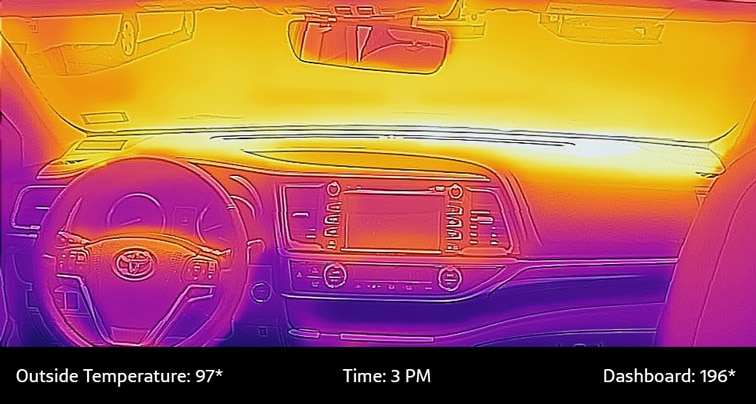 Aaron Miller
Aaron Miller
For more than a century, car makers and drivers have been waging a largely losing battle to keep their vehicles cool in the summer.
Cadillac introduced the first car with a fully-enclosed cabin in 1910, thus solving one problem – shielding passengers from rain and mud splatter – and introducing another, as the automobile became a greenhouse on wheels. The sun’s energy enters through the windows, is absorbed by interior surfaces, then trapped inside the car, making cabin temperatures hotter than the outside world.
Ever since then, keeping parked vehicles cool has been an exercise in futility. Packard introduced air conditioning shortly before WWII. Cadillac introduced climate control a quarter century later and, in the late 1990s, the Swedish engineers at Saab found that blowing air through seating surfaces helps maintain comfort during the “scorching” Scandinavian summer. None solve the problem of how hot your car gets when it’s roasting in the sun.
Along the way, a slew of homebrew methods popped up in a desperate attempt to beat the oppressive summertime heat. People use miniature fans, place sunshades in windshields, keep windows and sunroofs slightly open and, in extreme cases, even wear expensive, specialized clothing that circulates ice water. For various reasons, none of them work very well, either.
With that in mind, we set out to find the best ways to keep cars cool. After testing some of the most common methods to reduce heat buildup inside a car, we inadvertently busted a few age-old myths and learned a few helpful tips. At the end of the day, Mother Nature and the laws of physics will win the war, but you can still eek out a victory here and there.
Getting scientific with it
We parked two cars in direct sunlight in Dallas in July, in the middle of a heat wave. Both cars baked for a full working day, taking the sun’s abuse from 9 a.m. to 5 p.m. One had everything working in its favor: it’s white, which theoretically reflects the most heat of any color, and it has tint that blocks 50 – 60% of all solar energy on every window, including the windshield.1,2 The other car is black with no tint. In theory, anyway, the difference should be dramatic.
1: Note: installing tint on windshields is legal in some states but not others. AAA has a helpful guide,
2: Information on the specific tint used can be found
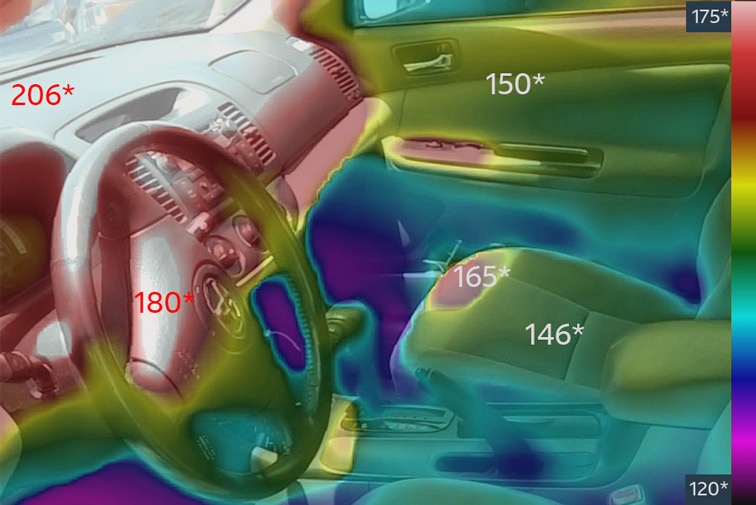 Aaron Miller
Aaron Miller
Yes, the black car with no tint got hot. Really hot.
We placed a thermometer in a shaded area within the black car to get an accurate read on the interior temperature. On a 103-degree day, the interior temp climbed to 141, nearly 37% above ambient. For context, the
Inside the white car with tint, on the same 103-degree day, the interior rose to 130. Still hot, but by comparison just a 26% increase.
Yes, the combination of tint and paint color made a notable difference, but the car was still unlivable.
That hardly tells the whole story, though.
With the sun directly overhead, you can almost boil water
Take a close look at the above image of the car with no protection from the sun, taken at high noon. We used an infrared camera to measure how hot different areas of the car can get. Every surface is hot after just three hours, but the dashboard reaches 206 degrees, which is a different level of hot. You wouldn’t put your hand in a pot of water that’s nearly about to boil (water boils at 212 Fahrenheit), and you certainly don’t want to touch a dashboard at this temp.
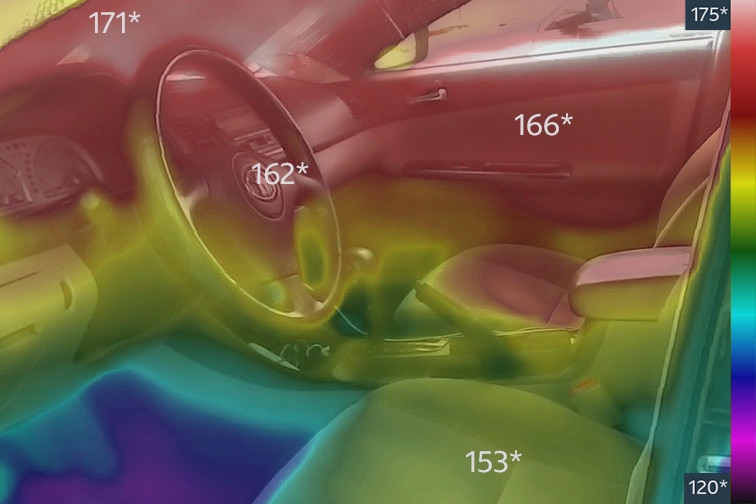
Sun shades really do work…sorta
The next day, we parked the black car in the same spot, placed a sun shade lined with reflective foil in the windshield, and set the DFW oven to Hot. The high outside climbed to 107. Inside? 138. For those keeping score at home, that’s a 29% gain relative to the outside world – more than the white car with tint, but not by much.
The reason for this is relatively obvious: whereas tint blocked 50-60% of solar energy in every window, the sunshade blocked much more, but only for the windshield, which happens to be the largest window in most cars.
 Aaron Miller
Aaron Miller
...but you need tint if you want your seats to stay cool (relatively speaking)
We’ll discuss seat temperatures and types (leather vs. cloth) more in a minute, but because the sun shade didn’t prevent sun from beating down on the seats via other windows, there was no noteworthy difference in the temperature of the seats with or without the sunshade. In the car without tint, seat surfaces ranged from 155 to 178 degrees, depending on where the sun hit them, regardless of whether the sun shade was used. That’s a gain of 14 to 30 degrees beyond the temperature inside the car.
With tint, the range was a much more temperate 135 to 144 degrees – only five 5 to 14 degrees warmer.
In other words, if you want to feel cooler, tint does help if you’re parking in the sun. More importantly, if your car is already cool (for example, if you park in a parking garage, etc.), the tint’s ability to prevent that extra thermal energy from entering your car will help your air conditioning do its job much more effectively.
The color of your car matters less than you think
All other factors being equal, it’s true that a darker color will absorb more heat than a lighter one, but the shine of a surface matters more. That’s because, in addition to attracting us like moths to a flame, a shiny object reflects more light – including infrared light, a.k.a. thermal radiation. If you’ve ever stood next to a glass building and felt the heat of the sun in its reflection, you’ve experienced this. For this reason, a very shiny black car will reject more heat than a matte white car.
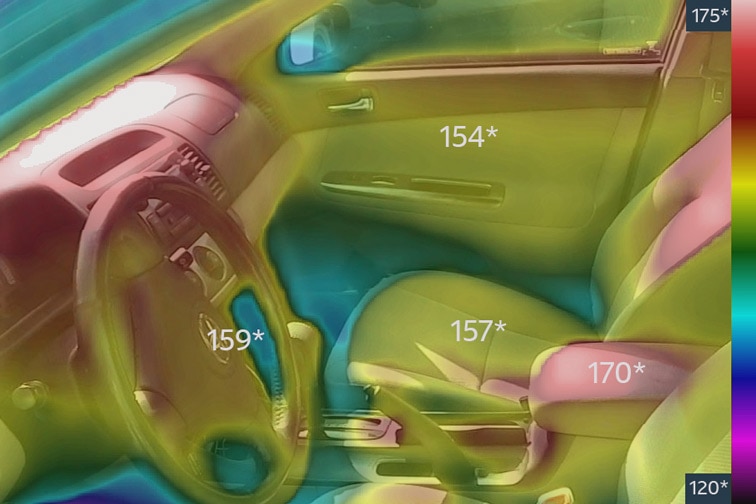 Aaron Miller
Aaron Miller
Cloth seats get just as hot as leather… they just feel cooler
Perhaps the most surprising thing we discovered when we started looking at everything in infrared is that cloth seats get every bit as hot as vinyl or leather seats. At first, we thought solar heating could have been the culprit, but look at the parts of the seat in the shade: even when not in direct sunlight, the cloth seats in our black tester were 12% hotter than the ambient interior temp. The same comparison on the other car? Under 4% warmer.
That runs counter to the collective experience of everyone who has ever been unfortunate enough to touch bare skin to vinyl or leather in a piping hot car, but the infrared evidence is undeniable.
What gives?
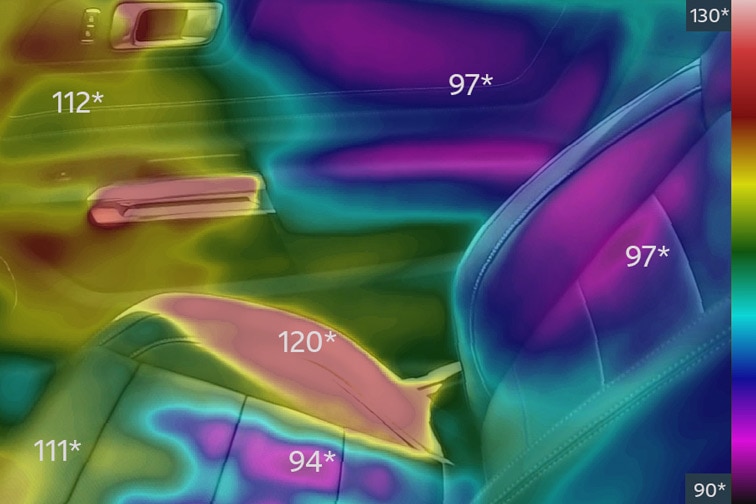 Aaron Miller
Aaron Miller
Ventilated seats can be a game-changer
Though they’ve technically been on the market for a couple of decades, the majority of vehicles still don’t come with ventilated seats. That’s a shame, because a fan blowing cool air (either directly from the A/C or ambient air from the coolest point in the car), is a game-changer. We tested the ventilated seats on a third car, and the image above shows the result after five minutes of blasting both the AC and ventilated seats. Note that the temperature on the seat bottom (the blue/purple spot) is down dramatically from parts of the seat that were in the shade (94 degrees vs 111). It’s even cooler on the seat bottom than on the door and seatback, which were hit by the AC. No, ventilated seats won’t keep your car cool while it bakes all day, but when you’re driving down the road on a hot day, it can feel like a godsend.
Tying the lessons together: How to Keep Your Car Cool
It should go without saying that the moral of all this testing is to park in a parking garage or covered space if at all possible. If you must park in the sun, here are a few key takeaways from our experiments:
- Keep your car shiny. That doesn’t mean you have to obsessively polish it every weekend, but you might want to consider the finish (gloss vs matte) as a factor when you buy.
- Don’t let geography dictate color. While we didn’t disprove the notion that light-colored cars are cooler, we did find plenty of evidence to show the effect is minimal at best.
- Get the best tint you can afford.
- Combine it with a sunshade. One with a shiny (foil) outside lining will work best. Also, if you have a moonroof, keep the shade closed there as well to prevent additional heating.
- Ventilated seats are an option worth having. Provided the car you want offers them. If it doesn’t, you can buy aftermarket seat coolers, but installing them is not for the average do-it-yourselfer.
- Give cloth a chance. Yes, it’s technically going to stay hot a little longer, but not scorching yourself on leather or vinyl counts for a lot here. As a bonus: some cars offer cloth steering wheels (usually as a branded microfiber suede like Alcantara). If you want to make sure you retain all your fingerprints when you grab the wheel and don’t want to be the only person wearing gloves on a hundred-degree day, it’s your best bet.
Leaving the windows open is a common mistake
Let’s address the elephant in the room: Leaving your windows open gives heat an easy way out. That goes a long way toward reducing the buildup of heat in your car, but it can also cause more problems than it solves. If you leave your windows open – or even cracked – your car is so easy to break into
Written by humans.
Edited by humans.
 Aaron Miller
Aaron MillerAs a veteran automotive journalist, I have been fortunate enough to drive some of the most desirable cars on the planet and get to know some of the most important people in the industry. Before joining Capital One, I served as the Cars Editor for a major national website, and covered industry news and analysis for well-known automotive-specific sites. I also wrote feature articles and reviews for niche enthusiast websites. I’ve been obsessed with cars since—literally—before I can remember, with my collection of die-cast and slot cars taking center stage during my formative years. Simply put, for me, working isn’t really “work.”
Related articles
View more related articles